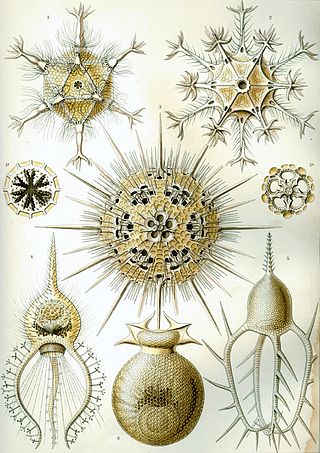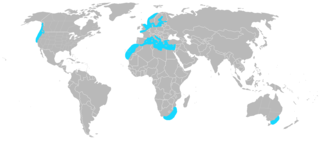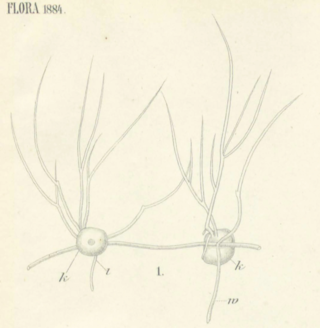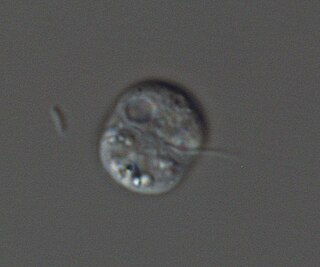
Cercozoa is a phylum of diverse single-celled eukaryotes. They lack shared morphological characteristics at the microscopic level, and are instead united by molecular phylogenies of rRNA and actin or polyubiquitin. They were the first major eukaryotic group to be recognized mainly through molecular phylogenies. They are the natural predators of many species of bacteria. They are closely related to the phylum Retaria, comprising amoeboids that usually have complex shells, and together form a supergroup called Rhizaria.

The Rhizaria are a diverse and species-rich supergroup of mostly unicellular eukaryotes. Except for the Chlorarachniophytes and three species in the genus Paulinella in the phylum Cercozoa, they are all non-photosynthetic, but many foraminifera and radiolaria have a symbiotic relationship with unicellular algae. A multicellular form, Guttulinopsis vulgaris, a cellular slime mold, has been described. This group was used by Cavalier-Smith in 2002, although the term "Rhizaria" had been long used for clades within the currently recognized taxon.

Phaeodarea or Phaeodaria is a group of amoeboid cercozoan organisms. They are traditionally considered radiolarians, but in molecular trees do not appear to be close relatives of the other groups, and are instead placed among the Cercozoa. They are distinguished by the structure of their central capsule and by the presence of a phaeodium, an aggregate of waste particles within the cell.

The Phytomyxea are a class of parasites that are cosmopolitan, obligate biotrophic protist parasites of plants, diatoms, oomycetes and brown algae. They are divided into the orders Plasmodiophorida and Phagomyxida. Plasmodiophorids are best known as pathogens or vectors for viruses of arable crops.

Endomyxa is a group of eukaryotic organisms in the supergroup Rhizaria. They were initially a subphylum of Cercozoa and later a subphylum of Retaria, but several analyses have proven they are a phylogenetically separate lineage, and Endomyxa is currently regarded as its own phylum.
Cryomonadida is a group of heterotrophic Rhizaria, that belong to the Cercozoa.

Thecofilosea is a class of unicellular testate amoebae belonging to the phylum Cercozoa. They are amoeboflagellates, organisms with flagella and pseudopodia, distinguished from other cercozoa by their scale-lacking test composed of organic material. They are closely related to the Imbricatea, a group of testate amoebae with tests composed of inorganic silica scales.

The spongomonads are a group of flagellated protists in the phylum Cercozoa. Taxonomically, they compose the family Sarcomonadidae and order Sarcomonadida. They were originally placed among the Reticulofilosa, but were later transferred to Monadofilosa. It includes only two genera:

Bigyra is a phylum of microscopic eukaryotes that are found at the base of the Stramenopiles clade. It includes three well-known heterotrophic groups Bicosoecida, Opalinata and Labyrinthulomycetes, as well as several small clades initially discovered through environmental DNA samples: Nanomonadea, Placididea, Opalomonadea and Eogyrea. The classification of Bigyra has changed several times since its origin, and its monophyly remains unresolved.

Opalozoa is a subphylum of heterotrophic protists of the phylum Bigyra, and is the sister group to Sagenista. Opalozoans are non-photosynthetic heterokonts that are ancestrally phagotrophic but many times have evolved to be osmotrophic saprotrophs in the gut of vertebrate animals.

The sarcomonads or class Sarcomonadea are a group of amoeboid biciliate protists in the phylum Cercozoa. They are characterized by a propensity to move through gliding on their posterior cilium or through filopodia, a lack of scales or external theca, a soft cell surface without obvious cortical filamentous or membranous skeleton, two cilia without scales or hairs, tubular mitochondrial cristae, near-spherical extrusomes, and a microbody attached to the nucleus.

Plasmodiophora is a genus in class Phytomyxea.

Plasmodiophora bicaudata is a marine pathogen, an obligate parasite of seagrass of the genus Zostera and the causal agent of wasting disease in the genus. These marine plants grow in fine sediment in shallow seas and the pathogen seems to have a worldwide distribution.
The initial version of a classification system of life by British zoologist Thomas Cavalier-Smith appeared in 1978. This initial system continued to be modified in subsequent versions that were published until he died in 2021. As with classifications of others, such as Carl Linnaeus, Ernst Haeckel, Robert Whittaker, and Carl Woese, Cavalier-Smith's classification attempts to incorporate the latest developments in taxonomy., Cavalier-Smith used his classifications to convey his opinions about the evolutionary relationships among various organisms, principally microbial. His classifications complemented his ideas communicated in scientific publications, talks, and diagrams. Different iterations might have a wider or narrow scope, include different groupings, provide greater or lesser detail, and place groups in different arrangements as his thinking changed. His classifications has been a major influence in the modern taxonomy, particularly of protists.
Leucodictyids are heterotrophic amoeboid protists that comprise the order Leucodictyida in the phylum Cercozoa.

Ligniera is a protist genus of the family Plasmodiophoraceae.

Phagomyxids are a group of obligate endoparasitic protists belonging to the subphylum Endomyxa in Cercozoa. Taxonomically, they are united under a single family Phagomyxidae, order Phagomyxida, sister to the plasmodiophores.

Tetramyxa parasitica is a species of parasitic cercozoan, member of the plasmodiophorids, that causes gall formation on multiple genera of aquatic plants. It was first discovered on roots of Ruppia and described by Karl von Goebel in 1884 in his work Flora, where it became the type species of the genus Tetramyxa.
Massisteriidae is a family of granofilosean protists within the phylum Cercozoa.

Rhogostoma minus is a species of thecate amoeba that belongs to the phylum Cercozoa. It was first described by Belar in 1921. These amoebae are heterotrophic, which means that they consume other organisms for nutrition. The cells of Rhogostoma minus are typically between 8 and 12 μm in diameter and are surrounded by a protective organic covering called a theca. The theca has a unique cleft-like opening that allows the amoebae to extend and retract thread-like projections called filose pseudopodia. The amoebae move along surfaces by pulling themselves forward using their pseudopodia.














